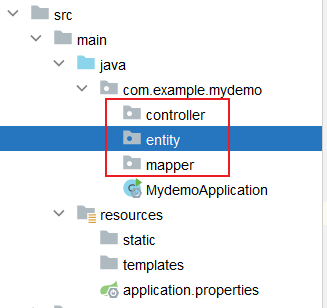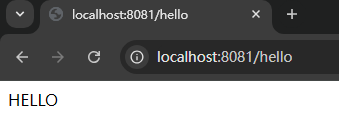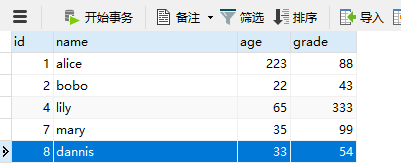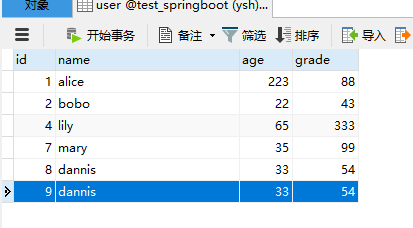前后端分离但人不分离:IDEA+VUE创建springboot项目和对应的前端项目
参考链接:
- 尚硅谷IDEA安装idea实战教程(百万播放,新版来袭)_哔哩哔哩_bilibili
- IntelliJ IDEA的使用指南,最简单的idea使用教程【适合初学者小白】_哔哩哔哩_bilibili
- SpringBoot项目后端开发逻辑梳理总结_一个springboot 项目,解释目录bean 、controller 、dao 、service-CSDN博客
- Springboot极简入门教程,5分钟写一个http接口_哔哩哔哩_bilibili
- Springboot+vue入门课程之增删改查_哔哩哔哩_bilibili
环境要求:
- 安装IDEA
- 安装mysql、Navicat
- 配置好maven
- 安装vue-cli
- 安装postman
思想:
- 用IDEA创建springboot项目,并同时勾选依赖 springboot web, mysql, mybatics, lombok
- 设置连接数据库,写一个测试接口 hello,用浏览器测试成功后开始写对数据库的crud接口
- 在后端测试成功后,写前端项目,在前端项目中用axios访问get、post请求,并返回结果
- 在前端测试成功后,打包前端项目,并把打包后的dist文件夹中的内容放到idea项目的 src/main/resources/static 目录下
- idea服务器重启,即可用后端的地址正常访问。
- 因为图片太多,所以展示时选择了缩小,看不清可以 右键 | 在新标签页打开图片
一、查看要操作的数据库
user表

选中表user,右键“设计表”可以看到属性类型

二、用idea创建springboot项目
File | New | Project

Next

Create,等待项目下载完成

项目下载完成后,目录如下。关掉无关页面,双击打开 pom.xml。如果有忘记安装的依赖可以在这里写入,然后刷新maven安装。


打开 application.properties 默认内容如下

添加连接数据库的配置

spring.application.name=mydemo server.port=8081 spring.datasource.url=jdbc:mysql://localhost:3306/test_springboot?useSSL=false&useUnicode=true&characterEncoding=utf-8 spring.datasource.username=root spring.datasource.password=1234 spring.datasource.driverClassName = com.mysql.cj.jdbc.Driver
开始写后端代码:在com.example.mydemo 下新建3个包 controller、mapper、entity

然后 entity 中新建一个 User类,按照数据库user表的列属性声明变量,并引入 @Data 注解

import lombok.Data; @Data public class User { private int id; private String name; private int age; private int grade; }
在mapper中新建 UserMapper 接口(暂时先不写内容)

在 controller 中新建 UserController.java, 并写一个测试接口
import org.springframework.web.bind.annotation.GetMapping; import org.springframework.web.bind.annotation.RestController; @RestController public class UserController { @GetMapping("/hello") public String hello() { return "HELLO"; } }
双击 MydemoApplication.java 打开,右键 Run,启动服务器


在浏览器地址栏输入 http://localhost:8081/hello ,页面显示 HELLO 表示正确。

三、写对数据库操作的接口
先在 MydemoApplication.java 上加注解扫描mapper类
@MapperScan("com.example.mydemo.mapper")
然后在 UserMapper.java 中编写第一个查询接口
import com.example.mydemo.entity.User; import org.apache.ibatis.annotations.Select; import java.util.List; public interface UserMapper { @Select("select * from user") List<User> queryAll(); }
在UserController.java中调用 queryAll 并添加对应注解
import com.example.mydemo.mapper.UserMapper; import lombok.RequiredArgsConstructor; import org.springframework.web.bind.annotation.GetMapping; import org.springframework.web.bind.annotation.RestController; import java.util.List; @RestController @RequiredArgsConstructor public class UserController { private final UserMapper userMapper; @GetMapping("/hello") public String hello() { return "HELLO"; } @GetMapping("/findAll") public List<User> findAllUser() { return userMapper.queryAll(); } }
重启服务器,在浏览器输入 http://localhost:8081/findAll (注意大小写)就查到了数据,和数据库表中的数据一样。


四、在vue项目中调用 http://localhost:8081/findAll 接口
新建一个vue2项目,npm run serve 运行

安装 axios 详细过程可以参考 https://www.cnblogs.com/sunshine233/p/18334975
然后在HelloWorld.vue 中删除无用的代码,写布局和axios访问接口
<template>
<div class="hello">
<h2>测试和 springboot 项目配合使用接口</h2>
</div>
</template>
<script>
import axios from "axios";
export default {
name: 'HelloWorld',
data() {
return {
baseUrl: "http://localhost:8081"
}
},
mounted() {
this.testHello();
},
methods: {
testHello() {
const url = this.baseUrl + "/hello";
axios.get(url).then(res => {
console.log('res', res.data);
}).catch(err => {
console.log('err', err);
})
}
}
}
</script>
<style scoped></style>
但是运行后发现报错 has been blocked by CORS policy: No 'Access-Control-Allow-Origin' header is present on the requested resource.

这是因为跨域了。跨域有很多种解决办法,这里我使用最简单的一种:后端代码controller类上加注解 @CrossOrigin 然后重启服务器。

刷新前端页面,没有报错并返回 HELLO

然后在前端页面中调用 /findAll 接口,成功返回数据。
/** * 访问"查询所有信息"接口 * 成功返回 所有信息json */ testGetAllRecords() { const url = this.baseUrl + "/findAll"; axios.get(url).then(res => { console.log('res.data', res.data); }).catch(err => { console.log('err', err); }) }

五、编写、测试post接口
在mapper中编写插入、修改接口
package com.example.mydemo.mapper; import com.example.mydemo.entity.User; import org.apache.ibatis.annotations.Select; import org.apache.ibatis.annotations.Update; import org.springframework.transaction.annotation.Transactional; import java.util.List; public interface UserMapper { @Select("select * from user") List<User> queryAll(); @Update("insert into user(name, age,grade) values(#{name}, #{age}, #{grade})") @Transactional void insertRecord(User user); @Update("update user set name=#{name}, age=#{age}, grade=#{grade} where id=#{id}") @Transactional void updateRecordById(User user); }
在controller中调用mapper接口
package com.example.mydemo.controller; import com.example.mydemo.entity.User; import com.example.mydemo.mapper.UserMapper; import lombok.RequiredArgsConstructor; import org.springframework.web.bind.annotation.*; import java.util.List; @CrossOrigin @RestController @RequiredArgsConstructor public class UserController { private final UserMapper userMapper; @GetMapping("/hello") public String hello() { return "HELLO"; } @GetMapping("/findAll") public List<User> findAllUser() { return userMapper.queryAll(); } @PostMapping("/insertRecord") public String insertUser(@RequestBody User user) { userMapper.insertRecord(user); return "插入数据成功!"; } @PostMapping("/updateRecord") public String updateUser(@RequestBody User user) { userMapper.updateRecordById(user); return "更新数据成功!"; } }
重启服务器。因为浏览器不能模拟post请求,所以需要用postman进行post请求。

注意body类型,数据插入成功。

然后在前端测试插入数据。
/** * 访问"插入数据"接口 * 成功返回 “插入数据成功!” */ testPostInsertRecord() { const url = this.baseUrl + "/insertRecord"; const newRecord = { "name": "dannis", "age": 33, "grade": 54 }; axios({ url: url, method: 'post', "content-type": "application/x-www-form-urlencoded", data: newRecord }).then((res) => { console.log("res.data:", res.data); }).catch((err) => { console.log("err:", err); }); },
运行后插入成功。

刷新数据库又多了一条新数据

但此时插入的数据是写死的,为了能插入动态的数据,我们需要再前端页面增加输入框。
<template>
<div class="hello">
<h2>测试和 springboot 项目配合使用接口</h2>
<div>
<div class="input-box">
<p>name:</p>
<input v-model="userInfo.name" />
<br>
<p>age:</p>
<input v-model="userInfo.age" />
<br>
<p>grade:</p>
<input v-model="userInfo.grade" />
</div>
<button @click="testPostInsertRecord">插入数据</button>
</div>
</div>
</template>
<script>
import axios from "axios";
export default {
name: 'HelloWorld',
data() {
return {
baseUrl: "http://localhost:8081",
userInfo: {
name: "",
age: null,
grade: null
}
}
},
mounted() {
// this.testPostInsertRecord();
},
methods: {
/**
* 访问测试接口
* 成功返回 HELLO
*/
testHello() {
const url = this.baseUrl + "/hello";
axios.get(url).then(res => {
console.log('res.data', res.data);
}).catch(err => {
console.log('err', err);
})
},
/**
* 访问"查询所有信息"接口
* 成功返回 所有信息json
*/
testGetAllRecords() {
const url = this.baseUrl + "/findAll";
axios.get(url).then(res => {
console.log('res.data', res.data);
}).catch(err => {
console.log('err', err);
})
},
/**
* 访问"插入数据"接口
* 成功返回 “插入数据成功!”
*/
testPostInsertRecord() {
const url = this.baseUrl + "/insertRecord";
// const newRecord = {
// "name": "dannis",
// "age": 33,
// "grade": 54
// };
axios({
url: url,
method: 'post',
"content-type": "application/x-www-form-urlencoded",
data: this.userInfo
}).then((res) => {
console.log("res.data:", res.data);
}).catch((err) => {
console.log("err:", err);
});
},
}
}
</script>
<style scoped>
.input-box p {
display: inline-block;
width: 60px;
}
</style>
插入数据成功


为了方便查看,在前端把查到的所有用户信息显示出来。
<template>
<div class="hello">
<h2>测试和 springboot 项目配合使用接口</h2>
<div class="input-box">
<p>name:</p>
<input v-model="userInfo.name" />
<br>
<p>age:</p>
<input v-model="userInfo.age" />
<br>
<p>grade:</p>
<input v-model="userInfo.grade" />
</div>
<button @click="testPostInsertRecord">插入数据</button>
<table cellspacing="10">
<tr>
<th>id</th>
<th>name</th>
<th>age</th>
<th>grade</th>
</tr>
<tr v-for="record in allRecords" :key="record.id">
<td>{{ record.id }}</td>
<td>{{ record.name }}</td>
<td>{{ record.age }}</td>
<td>{{ record.grade }}</td>
</tr>
</table>
</div>
</template>
<script>
import axios from "axios";
export default {
name: 'HelloWorld',
data() {
return {
baseUrl: "http://localhost:8081",
allRecords: [],
userInfo: {
name: "",
age: null,
grade: null
}
}
},
mounted() {
this.testGetAllRecords();
},
methods: {
/**
* 访问测试接口
* 成功返回 HELLO
*/
testHello() {
const url = this.baseUrl + "/hello";
axios.get(url).then(res => {
console.log('res.data', res.data);
}).catch(err => {
console.log('err', err);
})
},
/**
* 访问"查询所有信息"接口
* 成功返回 所有信息json
*/
testGetAllRecords() {
const url = this.baseUrl + "/findAll";
axios.get(url).then(res => {
console.log('res.data', res.data);
this.allRecords = res.data;
}).catch(err => {
console.log('err', err);
})
},
/**
* 访问"插入数据"接口
* 成功返回 “插入数据成功!”
*/
testPostInsertRecord() {
const url = this.baseUrl + "/insertRecord";
axios({
url: url,
method: 'post',
"content-type": "application/x-www-form-urlencoded",
data: this.userInfo
}).then((res) => {
console.log("res.data:", res.data);
// 插入成功后刷新数据
this.testGetAllRecords();
}).catch((err) => {
console.log("err:", err);
});
},
}
}
</script>
<style scoped>
.input-box p {
display: inline-block;
width: 60px;
}
table {
background-color: aqua;
margin: 20px auto;
}
</style>
插入成功后自动刷新结果

更新、删除以此类推


六、全部代码
全部代码如下(点击展开):
后端代码:
UserController.java

package com.example.mydemo.controller; import com.example.mydemo.entity.User; import com.example.mydemo.mapper.UserMapper; import lombok.RequiredArgsConstructor; import org.springframework.web.bind.annotation.*; import java.util.List; @CrossOrigin @RestController @RequiredArgsConstructor public class UserController { private final UserMapper userMapper; @GetMapping("/hello") public String hello() { return "HELLO"; } @GetMapping("/findAll") public List<User> findAllUser() { return userMapper.queryAll(); } @PostMapping("/insertRecord") public String insertUser(@RequestBody User user) { userMapper.insertRecord(user); return "插入数据成功!"; } @PostMapping("/updateRecord") public String updateUser(@RequestBody User user) { userMapper.updateRecordById(user); return "更新数据成功!"; } @DeleteMapping("/deleteRecord/{id}") public String deleteUser(@PathVariable int id) { userMapper.delRecordById(id); return "删除数据成功!"; } }
UserMapper.java

package com.example.mydemo.mapper; import com.example.mydemo.entity.User; import org.apache.ibatis.annotations.Delete; import org.apache.ibatis.annotations.Select; import org.apache.ibatis.annotations.Update; import org.springframework.transaction.annotation.Transactional; import java.util.List; public interface UserMapper { @Select("select * from user") List<User> queryAll(); @Update("insert into user(name, age,grade) values(#{name}, #{age}, #{grade})") @Transactional void insertRecord(User user); @Update("update user set name=#{name}, age=#{age}, grade=#{grade} where id=#{id}") @Transactional void updateRecordById(User user); @Delete("delete from user where id=#{id}") @Transactional void delRecordById(int id); }
User.java

package com.example.mydemo.entity; import lombok.Data; @Data public class User { private int id; private String name; private int age; private int grade; }
MydemoApplication.java

package com.example.mydemo; import org.mybatis.spring.annotation.MapperScan; import org.springframework.boot.SpringApplication; import org.springframework.boot.autoconfigure.SpringBootApplication; @SpringBootApplication @MapperScan("com.example.mydemo.mapper") public class MydemoApplication { public static void main(String[] args) { SpringApplication.run(MydemoApplication.class, args); } }
application.properties

spring.application.name=mydemo server.port=8081 spring.datasource.url=jdbc:mysql://localhost:3306/test_springboot?useSSL=false&useUnicode=true&characterEncoding=utf-8 spring.datasource.username=root spring.datasource.password=1234 spring.datasource.driverClassName = com.mysql.cj.jdbc.Driver
前端代码
HelloWorld.vue

<template>
<div class="hello">
<h2>测试和 springboot 项目配合使用接口</h2>
<div class="input-box">
<p>name:</p>
<input v-model="userInfo.name" />
<br>
<p>age:</p>
<input v-model="userInfo.age" />
<br>
<p>grade:</p>
<input v-model="userInfo.grade" />
</div>
<button @click="testPostInsertRecord">插入数据</button>
<hr>
<table cellspacing="10">
<tr>
<th>id</th>
<th>name</th>
<th>age</th>
<th>grade</th>
<th>操作</th>
</tr>
<tr v-for="record in allRecords" :key="record.id">
<td>{{ record.id }}</td>
<td>{{ record.name }}</td>
<td>{{ record.age }}</td>
<td>{{ record.grade }}</td>
<td>
<button @click="startUpdate(record)">更新</button>
<button @click="testDelRecord(record)">删除</button>
</td>
</tr>
</table>
<div class="input-box" style="background-color: aquamarine;">
<h4>在这里输入更新后的数据!</h4>
<p>id:</p>
<input v-model="updateRecord.id" disabled />
<br>
<p>name:</p>
<input v-model="updateRecord.name" />
<br>
<p>age:</p>
<input v-model="updateRecord.age" />
<br>
<p>grade:</p>
<input v-model="updateRecord.grade" />
<br>
<button @click="testPostUpdateRecord()">确认更新</button>
</div>
</div>
</template>
<script>
import axios from "axios";
export default {
name: 'HelloWorld',
data() {
return {
baseUrl: "http://localhost:8081",
allRecords: [],
// 插入信息绑定的变量
userInfo: {
name: "",
age: null,
grade: null
},
// 更新信息绑定的变量
updateRecord: {}
}
},
mounted() {
this.testGetAllRecords();
},
watch: {
allRecords(newvalue, oldvalue) {
console.log({ newvalue });
console.log({ oldvalue });
}
},
methods: {
/**
* 访问测试接口
* 成功返回 HELLO
*/
testHello() {
const url = this.baseUrl + "/hello";
axios.get(url).then(res => {
console.log('res.data', res.data);
}).catch(err => {
console.log('err', err);
})
},
/**
* 访问"查询所有信息"接口
* 成功返回 所有信息json
*/
testGetAllRecords() {
const url = this.baseUrl + "/findAll";
axios.get(url).then(res => {
console.log('res.data', res.data);
this.allRecords = res.data;
}).catch(err => {
console.log('err', err);
})
},
/**
* 访问"插入数据"接口
* 成功返回 “插入数据成功!”
*/
testPostInsertRecord() {
const url = this.baseUrl + "/insertRecord";
axios({
url: url,
method: 'post',
"content-type": "application/x-www-form-urlencoded",
data: this.userInfo
}).then((res) => {
console.log("res.data:", res.data);
// 插入成功后刷新数据
this.testGetAllRecords();
}).catch((err) => {
console.log("err:", err);
});
},
/**
* 选中一行数据,准备进行更新
*/
startUpdate(record) {
this.updateRecord = record;
},
/**
* 更新选中的记录
*/
testPostUpdateRecord() {
const url = this.baseUrl + "/updateRecord";
axios({
url: url,
method: 'post',
"content-type": "application/x-www-form-urlencoded",
data: this.updateRecord
}).then((res) => {
console.log("res.data:", res.data);
// this.testGetAllRecords();
}).catch((err) => {
console.log("err:", err);
});
},
/**
* 删除选中的记录
*/
testDelRecord(record) {
const url = this.baseUrl + "/deleteRecord/" + record.id;
axios({
url: url,
method: 'delete',
}).then((res) => {
console.log("res.data:", res.data);
this.testGetAllRecords();
}).catch((err) => {
console.log("err:", err);
});
}
}
}
</script>
<style scoped>
.input-box p {
display: inline-block;
width: 60px;
}
table {
background-color: aqua;
margin: 20px auto;
}
</style>
七、 打包放到服务器上
前端项目运行 npm run build 生成dist文件夹

复制文件夹内容,粘贴到 src/main/resources/static 下

重启服务器,访问 http://localhost:8081/ 可以看到和前端项目一样的页面,并可以执行功能。





